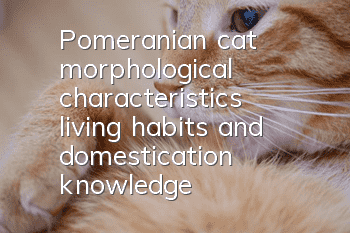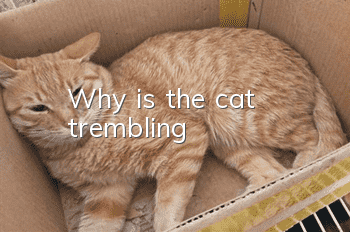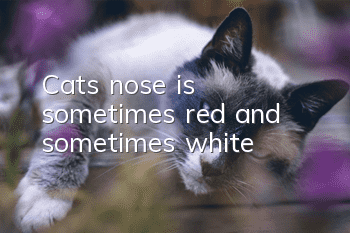Pomeranian cat morphological characteristics, living habits and domestication knowledge

Pomera Cat (Burmilla), also called Pomilla cat, originates from the United Kingdom. It is the offspring of a cross between Burmese cat and Chinchilla long-haired cat. In 1981, Baroness Miranda von Kerchberg of the United Kingdom bred the first Pomera cat, and it made its debut at a show held by the Cat Association in 1983. Later, Charles and Therese *** bred another lineage of Pomera cats with beautiful markings. They combined the two breeds to create offspring with better quality.
The historical origin of the Pomeranian cat
Pomilla cats combine the beauty of Chinchilla and the thoughtfulness of Burmese cats. There is also a beautiful love story in it. It is said that a long time ago, there was a princess Jinjila who was sent to meet a prince Jinjila and create a beautiful family together. Princess Jinjila escaped from the careless servant's hands and became a child. Carefully entering the forbidden place she shouldn't have entered - the study. In the study lived a handsome Burmese cat prince. Princess Jinjila and the Burmese cat prince tasted the forbidden fruit when the moon was dark and the wind was high, and they gave birth to a child. Super cute burmilla.
Pomeran cat morphological characteristics
In terms of appearance, the bottom is almost white, and the tips of the fur show a light purple color. There are dark markings on the head, tail and legs. The thin and short fur is close to the skin and is extremely soft to the touch. The wedge-shaped head has an obvious concave nose bridge, coupled with the reddish-brown nose, the face alone is enough to make people talk about it. There are two emerald-like eyes on it, and the deep eyes are surrounded by a ring. The black eyeliner makes his eyes more focused and energetic. A long and thin tail is the most desirable characteristic of this breed. Although the gene for this characteristic has gradually become stable, individuals with short and thick tails still occasionally appear, so breeders are currently actively trying to eliminate this trait. Even so, the Pomera cat has surpassed the halo of the two famous cats and developed a unique set of characteristics. It is still loved by many breeders who love purebred cats and is known as a purebred with excellent quality. Cat Descendants.
Pomeran Cat Breed Standard
Body shape
Medium build, elegant posture but full of muscles; weight 3~6kg; bottom almost completely white, with lavender hair tips.
Head
Wedge-shaped short head.
Ears
Medium spacing.
Eyes
The color is green.
Nose
Obviously concave nose bridge, reddish-brown nose.
Coat color
Some darker markings can be seen on the head, legs and tail. This breed of catThere are many coat colors, including black, blue, brown and chocolate. Red, cream, etc. cats are not yet recognized in Australia.
Tail
Not very thick, tapering gradually at the end.
Hair type
There are both long-haired and short-haired ones. The hair is soft and docile and feels very comfortable to the touch.
Pomeranian cat personality characteristics
Pomilla cats have a very friendly personality and like to get along with people. They are the favorite cat breed among children. In addition to being able to mingle with its fellow cats, it can also get along harmoniously with other animals of its species. The concave nose bridge makes Pomera cats look a little more innocent, and its watery eyes always seem to be communicating with people. General.
Pomilla cats are sociable. For example, they know how to play with their owners. When their owners are happy, they will ask for more petting or snacks; when their owners are angry and are in a low mood, they will first Let the owner be quiet in his own space for a while, and then come back to accompany the owner after a while. If the owner has enough time, it is best to interact with Pomera cats every day. If the owner is busy at work, he should prepare toys for them in advance.
The superb social skills of Pomera cats are also reflected in getting along with children and other animals. Many cats cannot coexist peacefully with children or other animals, but Pomera cats do extremely well in this regard. Therefore, if there are children in the house or other animals are raised, the owner does not have to worry about them actively harming the children or fighting endlessly with other animals.
Pomeranian Cat Suitable People
Families with children or other mixed cats and dogs.
Dietary taboos
Pomilla cats have no special requirements for food. Many people abroad suggest using raw meat to feed Pomera cats, but this suggestion has caused widespread controversy. The debate centers around how safe raw meat is for cats. Supporters say that feeding raw meat can arouse cats' interest, and eating raw meat can reduce the probability of cats' dental problems, reduce body odor, prevent cats from eating undesirable chemical additives, and make cats stronger. Opponents say that raw meat may bring a series of adverse effects to cats, with parasitic diseases, diarrhea, vomiting, etc. being the most common phenomena.
How to train a Pomeranian cat
Pomilla cats are easy-going, lively, alert and intelligent by nature, so training Pomera cats is not a particularly difficult task as long as you master certain skills. Before training a Pomera cat, owners first need to be mentally prepared. Training a cat cannot be completed overnight. Sometimes the cat may not understand your instructions well, and sometimes the cat may not want to do your instructions at all.When encountering these difficulties, owners need to be patient and guide them. They must not lose their temper with the cat because they lose patience. Otherwise, the cat will become more and more unwilling to accept your training, and they will gradually develop a fear of you.
Pomilla cats are fun. During the training process, they may slack off or pretend not to hear the owner’s commands. These are feedbacks of their true inner thoughts. The owner does not need to be too forceful and can leave it until next time. train. And if the cat has learned a skill, the owner needs to repeatedly consolidate the training for the cat, otherwise some cats will forget what they have learned before. In fact, cats also have great potential, which is often not developed by owners. Therefore, in the process of daily maintenance, owners can continue to tap the potential of cats to complete more training.
- How to get your cat to get rid of its bad habit of scratching the wall with its paws?
- Regular check-ups for cats are important to keep your cats healthy!
- What’s wrong with cat’s split nails?
- Should different cats eat different cat foods?
- What are the signs that a Siamese male cat is in heat?
- Do I need an injection if my cat bites it?
- Can British Shorthair cats be neutered during estrus? The best time to neuter British Shorthair cats!
- How to treat colds in Siamese cats?
- Why is the cat sleepy?
- Are cats carnivores or omnivores?



